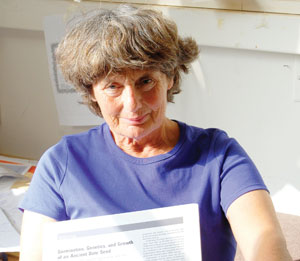 Jerusalem — One of the things that best symbolizes the holiday known in the Talmud as Rosh Hashanah l’ilanot, the New Year of the Trees, is dates. (The New Year of the Trees, Tu b’shevat, begins the evening of Jan. 19.) In fact, the date is one of the seven species mentioned in the Torah along with wheat, barley, grapes, figs, pomegranates and olives.
Jerusalem — One of the things that best symbolizes the holiday known in the Talmud as Rosh Hashanah l’ilanot, the New Year of the Trees, is dates. (The New Year of the Trees, Tu b’shevat, begins the evening of Jan. 19.) In fact, the date is one of the seven species mentioned in the Torah along with wheat, barley, grapes, figs, pomegranates and olives.
Sarah Sallon, M.D., director of the Louis Borick Natural Medicine Research Center at the Hadassah Medical Center in Jerusalem, studies medicinal plants of Israel. The center, which is funded entirely by donations, researches natural medicines and, according to Dr.Sallon, “one of the most important natural medicines comes from plants.”
In recent years she has become interested in rejuvenating lost flora of Eretz Yisrael.
“One of the lost flora is the Judaean date,” Dr. Sallon said.
When she learned that scientists were trying to extract DNA from ancient seeds, she wondered, “if we have ancient seeds, why couldn’t we grow them?”
The ancient seeds that Dr. Sallon is referring to are three date palm seeds which were found, along with other discoveries, at Masada, the palace of King Herod overlooking the Dead Sea. The site was excavated in the 1960s by archaeologist Yigal Yadin. The seeds were in the custodianship of Professor E. Netzer, the man in charge of Yadin’s collection, and stored at Bar Ilan University in Tel Aviv with Professor Mordechai Kislev, who identified them.
In 2005, Dr. Sallon’s colleague, Elaine Solowey, Ph.D., botanist of the Arava Institute for Environmental Studies at Kibbutz Ketura, took the three 2,000-year-old seeds and planted them. After eight weeks, one seed successfully germinated and was named Methuselah.
The exact location of the seedling, which is now a 2-meter-high (6 1/2 feet) tree, is a secret. Dr. Sallon said it is in a “protected quarantined site,” and she visits Methuselah every few months.
“We use the ancient language of the healers and apply them to modern conditions,” says Dr. Sallon, who has held positions with Hadassah University Hospital since 1983 and has been director of the Natural Medicine Research Center since 1994. “Looking at the date (Methuselah) and other ancient medicines is part of searching for (sources). It’s so precious to us.”
The center staff, consisting of about 25 people, collect seeds, grow plants, harvest them and then test them.
The Dali Lama has visited the center several times because it has done a lot of work on Tibetan plants.
“We have an interest in the highest place (Tibet) and the lowest place (the Dead Sea),” she said. “We grow plants at Kibbutz Ketura and test them at Hadassah School of Medicine, using ancient and historical sources like Maimonides and Ibn Sana.”
The center also translates ancient manuscripts on medicinal plants from Latin, Greek, Aramaic, Arabic, Hebrew and the Romance languages.
“We use the information to pinpoint what we want to test. Some have never been translated before. We call it ‘data mining.’ ”
Currently, researchers at the center are screening for tumors, otherwise known as cancers, and Parkinson’s (which is not named in the ancient writings but whose symptoms are described) as well as Alzheimer’s (described as memory loss). The loss of memory was a sign of aging in the ancient writings, thus the center is looking at plants traditionally used to improve people’s memory. Melancholy is today’s depression; coughing up blood is today’s tuberculosis.
Recently, the center tested in its early stages and isolated an interesting plant that could be used as a treatment for Parkinson’s.
“It shows an interesting affect in the laboratory,” Dr. Sallon said.
For now, Dr. Sallon said the tree [Methuselah] “looks like a regular date palm.”
“But we have to look more at its DNA. When we compared it to the DNA of a regular cultivated species of dates, it closely resembled the Egyptian type,” the doctor said.
Right now Methuselah is simply growing and not showing its sexual characteristics. Its sex will not be known for a few years.
“If it’s female, we’ll call it Mrs. Methuselah,” says Dr. Sallon. Potentially, it could be fertilized by pollen of a male date and possibly produce dates.